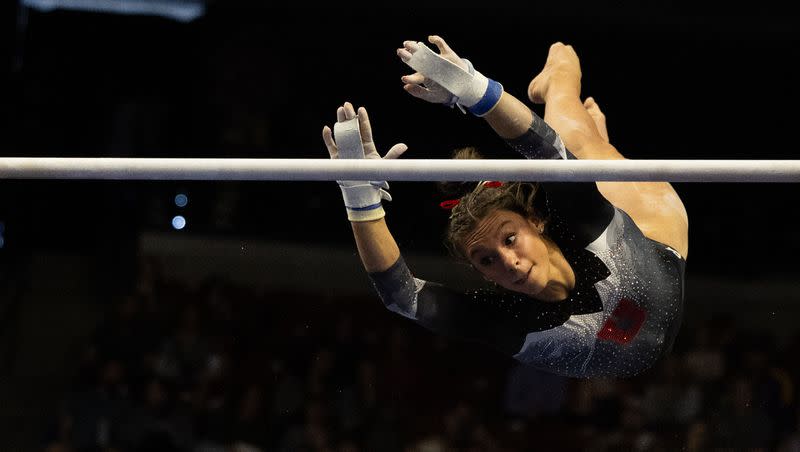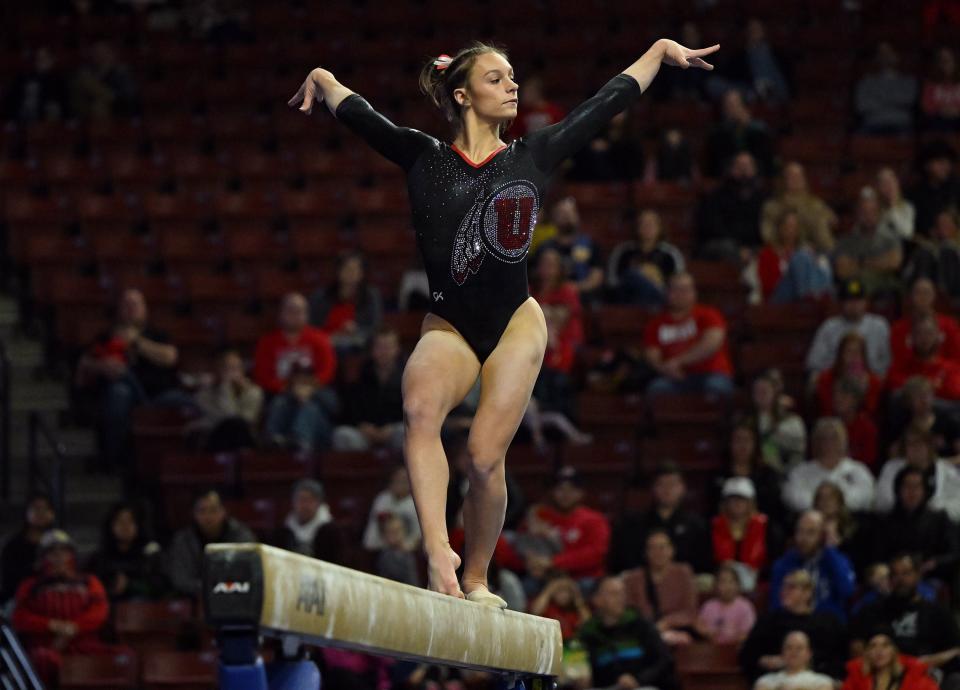How do Utah’s gymnasts feel about the new format for NCAA postseason meets?

Through no real fault of her own, Grace McCallum wasn’t ready.
Awaiting her turn to compete on the uneven bars Saturday night in the early-season showdown between Oklahoma, LSU, UCLA and the University of Utah — held at the Maverik Center in West Valley City — McCallum was not expecting to compete. At least not when she was called upon to.
But when the green flag goes up it is time to perform, so the Utah junior and Olympic silver medalist got on the bars when beckoned to and performed her routine.
All told, McCallum did well enough, earning a 9.850. That was the second-highest bars score by a Red Rock that night, behind only Maile O’Keefe’s 9.875.
But everything about the episode was just off.
“I didn’t know when I was going, where I was going,” McCallum said. “It was kind of hard for me. I had kind of a panic attack on bars because I was all of (a) sudden supposed to go.”
Related
Utah looked a lot more like Utah against BYU, Utah State and Southern Utah
Utah has work to do after nerve-marred showdown against Oklahoma, UCLA and LSU
Why was McCallum so unprepared to compete her routine? She is, after all, a veteran of an uncountable number of gymnastics meets at this point in her career, both at the elite level and in college.
It all has to do with a new meet format introduced by the NCAA this season.
Debuted over the holiday weekend, at least for Utah gymnastics, in the Sprouts Farmers Market Collegiate Quad, and then again on Monday at the Best of Utah, the new format is described as the “double dual quad meet format,” and it is designed to make four-team competition easier on the viewer.
The format works as follows:
Unlike in the past, when all four teams in a quad meet competed in their respective events at the same time, only two events are staged at the same time and the meet proceeds by alternating between the two groupings.
Vault and balance beam are paired together, and so are bars and floor exercise.
The purpose of the format is to allow fans to view more routines and do so more easily.
Watching four teams compete simultaneously is, in many ways, impossible. At least if the goal is to see at least part of every routine. That is one reason why team-specific streams have been a part of the national championship broadcast the last few years.
Additionally, by making four-team meets more like dual meets — where one team competes head-to-head with another — which is arguably the most interesting college gymnastics format, the hope was to add excitement to larger events.
It worked too, as the Sprouts Farmers Markey Collegiate Quad was the most watched regular-season collegiate gymnastics meet in ESPN history, peaking with nearly 800,000 viewers, with an average viewership of 634,000.
Session 2 of the inaugural Sprouts Farmers Market #CollegiateQuad on @ABCNetwork scored 634K viewers
• Most-watched live regular season #NCAAGym meet in ESPN history
• 4 of preseason top 5: @OU_WGymnastics, @LSUgym, @uclagymnastics & @UtahGymnastics
• Peak: 792K viewers pic.twitter.com/0wm9MrMXwo— ESPN PR (@ESPNPR) January 17, 2024
For the most part, the Red Rocks were happy to get exposed to the new meet format this early in the season.
It is a format they will see again at the Pac-12 championships and then throughout the NCAA postseason.
“It was really nice, early in the season to get the feel for how things are, to get a feel for the flow of everything,” senior Abby Paulson said. “... Since we will all be using that in postseason.”
Added junior Amelie Morgan: “Yeah, obviously there is a new format and we knew what it was but we weren’t quite adjusted to it yet. It definitely was nice knowing today that different things might happen that might not be the best and we were more prepared for those things to happen. I think it will get better as the season goes on, but it is a different format to get used to.”
There are clearly kinks to work out with the format, though, as referenced by Morgan and evidenced by McCallum’s experience.
Related
Avery Neff, the No. 1 prospect and a future Utah gymnast, was perfect to start 2024
Utah signee Poppy-Grace Stickler hospitalized with fractured back, hip
“For her (McCallum) truly this was the first time that we’ve tried this (format), that our team has done this,” Utah coach Carly Dockendorf said. “And it affected her more than anyone.
“What happened was on floor, it was floor’s turn (to go). I don’t know if their music wasn’t working or what, and then all of a sudden (the PA announcer) said, ‘And Grace is up on bars.’ And she wasn’t ready. It wasn’t her turn.”
Said McCallum: “The whole setup of TV time was kind of all over the place. I didn’t know.”
The experience was not ideal, though Dockendorf made sure not to blame any Utah mistakes on the meet format. And she noted that bugs like the one experienced by McCallum are the reason the format is being tested in January meets.
“I think that is why they are practicing this stuff now,” she said. “So when we get to nationals we will get to avoid some of those (situations). Because it was stressful for her (McCallum). It wasn’t her turn to go and then all of a sudden the green flag was up and it was time to go (compete).
“I don’t know if anyone else could’ve handled it as well as her, but those are some of the things that the NCAA is going to have to figure out so it is not so stressful for the athletes next time.”
The next time being when championships are on the line.


